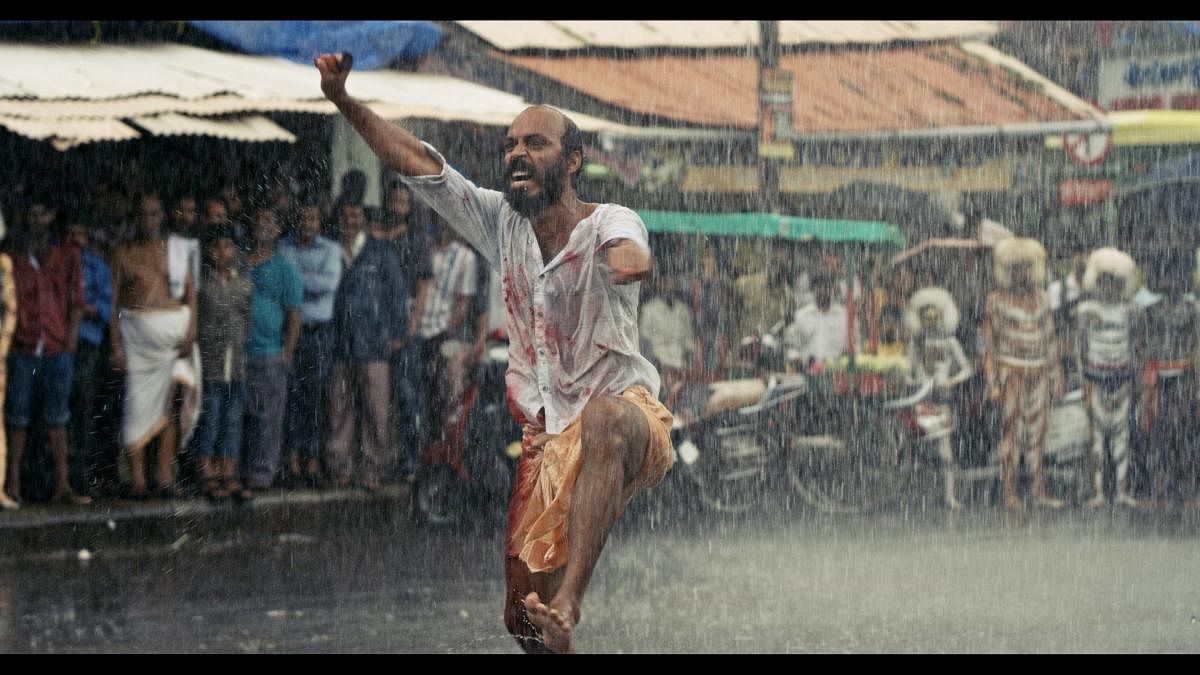
Raj B Shetty’s latest directorial ‘Garuda Gamana Vrishabha Vahana’ is a textbook example of how you can deliver a tried and tested formula in a fresh new form.
The film is a classic ‘cop vs criminal’ drama, but Raj packages it in a style novel to Kannada films. He plays Shiva, pitted against his childhood friend Hari (Rishabh Shetty), who later turns an antagonist.
Juxtaposition
A violent story with an almost all-male cast is located in the city of Mangaladevi, with a presiding deity people call ‘Devi’. ‘The demon in me’, a song used as the title rolls, should ideally have welcomed the audience to the world of Mangaladevi but it warns us to stay away from the demonic characters in her world.
Also, using electronic music with English lyrics in a film that later uses such traditional compositions as ‘Chandrachooda Shiva Shankara Parvathi’ and ‘Soojugada sooju mallige’ is unexpected, but it all works beautifully.
Episodic writing
‘GGVV’ is mounted on a big canvas. It has almost no short scenes: most are longer than five minutes, making the film episodic. A good example is the first scene at the police station where don Shiva’s character is introduced. One of the highlights of this film is how it shows the subtle shifts in power dynamics. What follows a hospital scene, where Hari is outraged at the harm caused to a character called Neethu, and another where the MLA slaps Brahmayya, (the police officer out to nab Hari and Shiva) are good examples of how Raj depicts the assertion of power.
Staging
Very few Kannada films show staging sensibilities like ‘GGVV’. Placing things within the four corners of a frame consciously to amplify the experience is a fundamental technique that unfortunately is given a go-by in a majority of mainstream films.
When a blood-stained Shiva is dancing in the rain in front of a temple, he has currency notes strewn at his feet and people waiting to harm him on his left. At the same time, powerful people stand to his right, guarding him and letting him dance away. This is a scene that will remain for a long time in memory.
Subtlety
Hari’s mother, cutting fish, can still detect an unfamiliar smell. A driver starts to empathise with his boss Brahmayya but that is seen only in his facial expression. Shiva cannot stab Hari although he has his knife handy. He breaks up with him by returning a bike he has received as a gift. Through all these, the dialogue is minimal.
Playing with time
The story evokes the idea of ‘kaala’ (time) and Raj plays with it, slowing down scenes and sometimes freezing them, even in situations when he has to capture intense moments of action, such as the antagonists running or riding a bike. Sometimes, the camera looks glitchy and hurried. The slow-mo shots serve two purposes — building suspense and elevating the character to mass expectations.
Character quirks
In several places, Raj explores character quirks. Shiva wears a particular kind of footwear, and plays with a paper-weight. The paper-weight also becomes a metaphor for Shiva, with its round, bald, and unassuming presence keeping heavier stuff pinned down.
Aural ambience
While the sync-sound adds an additional layer of authenticity, the added sound effects are excellent. You can clearly hear the sounds of a handkerchief being folded, a bracelet jiggling, coins dropping, and a crow cawing. The characteristic sound of a Yamaha motorcycle adds brilliantly to the atmospherics.
Camera talking
While the wide shots are absolutely stunning, the simple technique of the camera tracking close to the characters creates impact. In the scene dealing with the sand mafia, a wide shot shows Shiva and Hari on a bike with a long line of trucks following them. Everything is in slow motion, and a slow-soft song plays in the background, and the scene masterfully ends with a series of shots showing Hari changing his footwear.
‘GGVV’, much like ‘KGF’, reiterates that a regular massy plot can still deliver a totally new experience if the creators know their craft well. Raj is a remarkable writer-director who has made two stand-out films. And he has pulled this off with a bald hero in an industry that is always casting heroes for their dashing looks.
(The author is a freelancer who writes on films and entertainment)